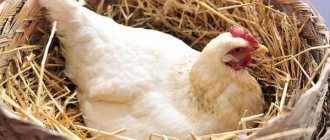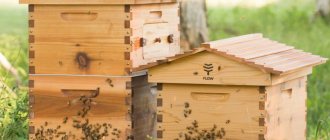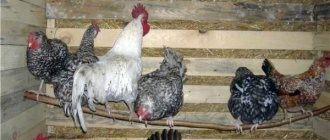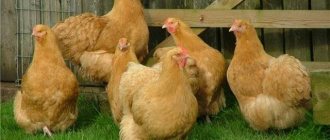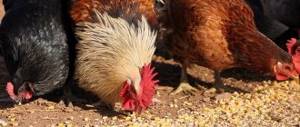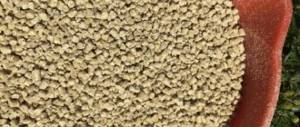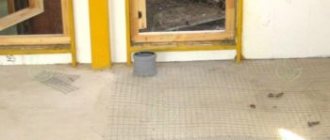Do-it-yourself cage for laying hens, drawings and dimensions. Cage sizes for laying hens
Standards for keeping chickens of egg and meat-egg breeds and crosses imply placement of 2 to 8 individuals per 1 square meter of area. The main criterion is the free access of each chicken to feed and water, so it is advisable to make the cage depth 50-60 cm, and its width, depending on the planned livestock, from 60 to 120 cm. Wider cages are inconvenient: the floors in them will sag, and the tray will become too heavy for the litter. The height of the cage from the mesh floor is 45 cm.
Cage for keeping laying hens
Recommended cage sizes for different numbers of laying hens of small egg breeds are shown in the table.
| Number of laying hens per cage | 2-3 | 4-5 | 6-8 | 9-12 |
| Cage depth, m | 0,5-0,6 | 0,5-0,6 | 0,6-0,8 | 0,7-1,0 |
| Cage width, m | 0,6-0,1 | 1,0-1,4 | 1,4-1,8 | 1,8-2,0 |
| Cage height at the rear wall, m | 0,45 | 0,45 | 0,5 | 0,5 |
| Total cage height, m | 0,65 | 0,65 | 0,7 | 0,7 |
| Area per bird, m2 | 0,1-0,3 | 0,1-0,21 | 0,1-0,24 | 0,1-0,22 |
For chickens of egg-meat breeds, the area must be increased by 30-40%.
Cages for laying hens
Important! Excessive crowding in cages will lead to anxiety in the birds, conflicts and fights, and decreased productivity!
Multi-tier cage
To maximize space savings in the premises with a large number of poultry, they resort to the manufacture of a multi-tiered design. The specifics of the construction have several criteria that must be met:
- the material of the cage floor should not sag under the weight of the bird and hang over the lower tier;
- the distance between floors is about 10 cm;
- a multi-tier cage involves the location of doors on the front wall - between the feeder and the chute for collecting eggs;
- if the unit is mobile in nature, the upper tier should be equipped with a ceiling covering that can hide the structure from rain when it is taken out into the external space;
- All cages should be equally illuminated and ventilated, and equipped with individual points for eating and drinking.
When preparing to work on a block, it is more convenient to draw up a drawing that will reflect the dimensions corresponding to the poultry house premises.
Variant of the drawing of a multi-tier cell battery
When chickens for different purposes are kept together, the egg breeds are placed on top, and the broiler breeds are given the lower rows of cages.
Do-it-yourself cages for laying hens, drawings and dimensions. Assembly according to drawings and dimensions
Do-it-yourself cage for laying hens, photos, drawings.
Further operations for assembling the cell block proceed approximately as follows (we will take as a basis a cell of three floors with two sections of the following dimensions - 1407 by 1660 by 700 mm):
- According to the dimensions of the cages for laying hens and the selected drawing, the material is cut. We prepare 4 bars 1407 mm long, 6 bars 1660 mm long, 4 bars 700 mm long. The ends of the wooden beams must be cleaned with sandpaper or using a grinding machine.
- A frame is assembled from sawn wooden beams.
To fasten the frame, you should use galvanized self-tapping screws - it is optimal to take two self-tapping screws for each fastening corner. NOTE! Along the side walls, the frame can be additionally reinforced with plywood corners - one piece of hardware for each corner. In total, about 50 screws may be required. - A lattice flooring is installed under the cage frame.
For this purpose, a 20 by 40 mm block of length 700 mm (7 pieces) is mainly used. The flooring is assembled in the same way as the frame. — one screw is screwed into each end of the beam. In total, you will need 6 screws, but it is better to take extra. Nails should not be used, as the block will simply crack when driving in the fastening component. - The back and side walls of the frame are sutured with mesh. The sheet dimensions are 1660 by 1407 mm, plus 5-10 centimeters, since the edges will bend. The edges of the mesh (if any) must be carefully folded.
The mesh is fastened using self-tapping screws with a wide head according to the same principle as in the case of installing the flooring.Please note that you can also use a sheet of plywood for the back wall.
- The front wall is intended for the door.
The door is also made of mesh measuring 50 by 50 mm. For the frame you will need two bars 470 mm long and two bars 700 mm long. We connect them together with self-tapping screws (one hardware for each end, 4 pieces in total). We stretch the mesh over the finished frame - bend it along the edges and fasten it with wide-headed screws, one every 2-3 centimeters. You can use bolts to close the door. - The frame is covered - the roof can be made of mesh or moisture-resistant plywood.
If plywood is used, the material must also be treated with an antiseptic. Plywood should be cut to the following dimensions - 1409 by 700 mm. We cover the upper part of the frame and fasten it with self-tapping screws or small nails. In the latter case, you will need about a hundred hardware, since they need to be driven in in increments of 1.5-2 centimeters. When using a self-tapping screw, you can maintain a step of 2-3 cm, therefore you will need 40-50 hardware.
The grating floor itself is made according to the size of the flooring area (1407 by 700 mm).
The mesh must be secured with wide-headed screws - one every 5 centimeters. The front edge is bent to the shape of the tray. To make the floor stronger, you can install wooden blocks in the form of stiffeners. However, the tree must be treated with an antiseptic.
Kinds
All cellular structures are divided into 2 large types:
- With bedding . This type is a structure with a solid floor covered with sawdust or straw.
- With egg collector and inclined flooring . The cage has a double flooring, where the upper part is a lattice, and the solid lower part is equipped with a retractable container (pallet). Due to the slope of the bottom, the eggs roll into a special mesh with indentations.
Do-it-yourself cage for laying hens with an egg collector. Types of structures
Breeders must properly organize the space in the chicken coop so that the birds continue to produce eggs at high intensity.
Cages for laying hens can be single- or multi-tiered, equipped with a feeder, a drinker, as well as a mesh floor and a special compartment for disposal of droppings.
Such boxes differ in the presence or absence of an egg collector. This element is represented by an inclined floor along which the egg rolls into a special tray. There are separate requirements for area. The productivity of a bird depends on its mobility. The dimensions of the cage for laying hens must correspond to this need.
The easiest way to switch from free-range to cage-based is to buy a finished product from the manufacturer.
The multi-tiered Cinderella model is popular on the market, equipped with automatic water supply, reliable metal doors and trays. The cost of such equipment is high, so a farmer who pursues industrial purposes in breeding chickens can make a purchase.
Factory strong and durable structures are purchased or created with your own hands. You can make cages for laying hens from any materials. It is better to use the most durable and durable metal and wood.
Varieties
There are different types of cages for chickens, which are selected depending on the capabilities of the breeder and the goals of breeding the birds.
However, they can be divided into two types:
With bedding
In such structures, a solid floor is made, which is sprinkled with a layer of straw or sawdust. The best material for its manufacture is wood, since the mat does not slip on a wooden floor.
When keeping laying hens on litter, the height of the cage must be increased by 15-20 cm. In addition, it can contain no more than 6 individuals.
With sloping floor and egg collector
In this case, a double floor is made. Its upper part is lattice and sloped, while the lower part is solid and often equipped with a pull-out tray. This cage is easy to keep dry and clean.
The eggs automatically roll down the inclined floor and fall into a special chute, so contact with the chickens will be minimal. You can make any type of cage with your own hands; first prepare the necessary drawings.
As a rule, cages for laying hens are made in groups. Each of them can contain from 7 to 10 individuals.
If the livestock is very large, you can assemble a cage battery - a single structure consisting of several rows and floors of cages.
Dimensions of a cage for laying hens with your own hands. Cage for laying hens: pros and cons
In a chicken house, animals are kept in the smallest possible area.
When constructing cages, it is imperative to provide an artificial lighting system
The advantages of these structures include:
- saving space, heat and lighting in winter;
- low costs for bedding cover;
- a simplified option for cleaning the structure compared to poultry pens;
- saving feed - chickens do not rake food with their paws, and due to a sedentary lifestyle, they burn a minimum of calories and eat less;
- reduction in water costs - drinking bowls remain clean, pieces of litter and various debris do not fall into them;
- the percentage of birds eaten by predators is close to zero;
- low risk of contracting diseases from contact with wild animals;
- simplified process of collecting eggs - you don’t need to look for them on the floor or in secluded places where free-roaming laying hens are used to laying eggs.
Cage keeping of birds has several disadvantages:
- due to the small space in chickens, the percentage of egg production may decrease - they are active creatures, they like to walk a lot;
- pets are limited in the consumption of natural food (greens, insects, plant seeds), which they get from free grazing, as a result of which they should be additionally fed with vitamin complexes and mineral mixtures;
- lack of sun, which saturates birds with vitamin D;
- instant spread of infection - in a confined space, the disease affects almost the entire livestock if proper measures are not taken in time.
What is it for?
Cage housing of laying hens to obtain marketable eggs has its advantages and disadvantages. Positive factors include:
complete mechanization of the process of feeding, watering, cleaning cells and obtaining the product itself (that is, eggs);- space is used economically, since even in a small building several cell blocks can be compactly concentrated, which makes it possible to keep a fairly large number of livestock;
- it is easy to create optimal conditions for the comfortable life of the bird - artificial lighting, ventilation, heating;
- the amount of feed is controlled, which also reduces the cost of the final product;
- Monitoring the condition of the bird and the procedure for conducting veterinary examinations, vaccinations, and so on are significantly simplified.
However, along with a fairly extensive list of advantages, this type of content also has some disadvantages. In this regard, the following factors should be highlighted:
- an incorrectly mounted cage can lead to injury to the bird or damage to the final product;
- due to the fact that the bird is kept in a rather limited area, it is less resistant to diseases. This is due to an insufficient amount (or even absence) of sunlight and fresh air;
- the costs of veterinary procedures increase significantly, in particular, more vitamins are required;
compound feed should be used of the best grade;- The microclimate in the room must be constantly regulated and the optimal temperature regime must be maintained.
Therefore, when using such a system, you should still have an area for birds to walk. Otherwise, the quality of the original product, as well as the life activity of the hen itself, will not be at the highest level.
In general, the layout of a DIY laying hen cage is fairly standardized, but there are slight differences in some components. Thus, the following cell types are considered:
- on the litter;
- with a sloping floor.
DIY cages for laying hens - drawings. A few words about cells
Homemade cages for chickens are becoming increasingly popular and you can assemble them yourself from scrap and cheap materials. They are convenient not only for breeding, but also for transporting birds. For small areas, cage housing is an excellent option, since they take up much less space than a chicken coop. And on each square meter of cage area, about five small chickens can easily be accommodated. Such a dwelling can be moved from place to place in the summer, placing it on fresh grass every day, thereby providing the birds with natural and vitamin-rich food.
Cages for keeping young animals
One of the advantages is also the ability to make sizes suitable for a given room and easily vary them.
Before starting construction, you should study the drawings. The drawings must include all dimensions of width, height and length, and also mark the locations for the feeders. The easiest way to make housing for chickens is from a metal mesh stretched over wooden blocks.
The correct dimensions are calculated from the total number of inhabitants. Cages for laying hens should be equipped with a tray to make the cleaning process easy and convenient.
How to get a good result?
There are only two ways. You either buy a ready-made cage or make your own cage, which you can make as comfortable as possible for yourself. The first option is much simpler, but the second is cheaper, which means that you don’t need to be lazy and give it preference. Having a minimal set of tools and materials at hand, you can easily build a simple structure for your laying hens yourself.
Cage for laying hens made of wood. Cages for laying hens
Chickens are kept in cages only if the area of the poultry house does not allow the birds to be raised in optimal conditions. However, this does not mean that such cultivation has a negative impact on productivity. With proper equipment of the premises and proper feeding, egg production does not decrease, and in some cases even increases for meat breeds.
In this article you will find useful information about such content, drawings and photos for making the necessary structures with your own hands, as well as thematic
Equipment Rules
The main features of designs for adults and chicks include several important points. Adult broilers, laying hens (about 50 heads), as well as young animals (no more than 100 heads) can use KBI models.
Laying hens (no more than 20 pieces) are often kept in CNI model designs.
Each of them is divided by special partitions into four sections, each of which can contain no more than five individuals.
Figure 1 shows a drawing and options for similar designs.
Figure 1. Equipment manufacturing options
Cell sizes with drawings
This kind of keeping is very popular among homestead owners, since this method allows you to compactly place the birds and make caring for them easier.
It is necessary to select the correct size of the product depending on the number of heads contained:
- For 2-3 chickens, an area of 0.1-0.3 sq.m per individual will be enough. The total height is 0.65 m, depth 0.5 m and width up to 1 meter.
- When keeping 5 individuals, each should have up to 0.21 sq.m of area. The height and depth remain the same, but the width increases to one and a half meters.
If the farm plans to keep 10-12 birds, each of them should have about one and a half square meters of area. The height increases to 70 cm, the depth is about a meter (but not less than 70 cm), and the width reaches two meters.
Schemes for making such products with your own hands are shown in Figure 2.
Possible problems
Cellular fatigue
Caging hens in cages tires their bones and muscles. The bird loses the ability to stand on its feet due to brittle bones. Because of this, she constantly lies down and stops eating.
Egg shells become thinner. When such a disease appears in chickens, you need to pay attention to their nutrition. Add calcium and phosphate to the menu.
Panic
When a hen is about to lay eggs, she needs privacy.
It is impossible to achieve such conditions in a cage. Because of this, the hen begins to panic. She begins to rush around the cage randomly, breaking off feathers and injuring her limbs. As a rule, this goes away after 2-3 layings.
The solution will be to isolate the restless bird and create comfort for it: a cozy nest, dim light, closed walls, warmth.
It is important to diversify her menu with useful substances. For example, fruits, vegetables, herbs, worms, chalk.
Cannibalism
Adult laying hens can show aggression towards cage mates. Peck, pounce. It is recommended to separate such chickens from the general flock.
If all else fails, the aggressor is slaughtered for meat.
Wing fracture
The fracture is difficult to detect if chickens are kept in cages. If your chicken can't straighten its wing, or if it's drooping, it may be injured or broken.
It’s the same with the paws if the bird falls and cannot get up. It is better to show the laying hen to a veterinarian. If this is not possible, you need to fix the affected wing or paw with a splint and bandage in its natural position.
Rickets
This disease is common among laying hens and young chickens. Signs of the disease: loose stools, loss of coordination and appetite, softening of the key and claws. It is not easy to recognize in the early stages.
Patients must be isolated and treated:
- tricalcium phosphate: 1.5 milliliters per 100 grams of feed;
- fish oil: 0.5 milliliters per 100 grams of food;
- vitamin D2 concentrate: 2-3 drops per kilogram of feed.
No matter how long chickens live in cages, all this time they need care. It is recommended to systematically inspect, monitor the nutrition and living conditions of laying hens.
Automatic cages for laying hens. Requirements for cages for laying hens
Cages for chickens, young animals and laying hens have different designs. In this case, not only the size of the bird is taken into account, but also the purpose of keeping it: cages for laying hens, for example, must be equipped with egg collectors.
Living in such a limited area shortens the lifespan of birds.
When breeding purebred chickens, this method of keeping is not applicable, but for egg and meat-egg chickens it is suitable. Read about the best breeds of laying hens here.
Laying cage with sloping floor
The cell must meet a number of requirements:
- It is mandatory to have an egg collector, which allows you to get eggs without disturbing the chicken. Without this device, at least half of the eggs will be consumed by the birds themselves;
- For cages, select a mesh with cells of such a size that the bird does not get stuck in them. The front wall of the cage, where the drinker and feeder are located, should have larger cells - 5 cm wide and 10 cm high - to guarantee free access to food;
- Artificial lighting is mandatory, since the length of daylight hours must be maintained constant;
- The cage floor must be strong enough to support the weight of the hens. To make cleaning easier, the floor is usually made of mesh;
- a tray is installed under the structure to collect litter;
- each cage must have a drinking bowl and feeder of the required size;
- devices must be removable so that they can be cleaned or repaired if necessary.
This article will tell you about the Russian white breed of chickens.
If laying hens are kept in cages, it is necessary to enrich their diet with mineral and vitamin supplements. When free-ranging, chickens peck worms, greens, and swallow pebbles to ensure normal stomach function. When kept in cages, all of the above must be provided by the owner.
Dimensions
Cage sizes are calculated based on the size of the bird, breed, material used and the number of individuals in one cage.
You cannot keep more than 6-7 laying hens in one cage. With a large number of individuals, it becomes difficult to care for them. In addition, when there is too much crowding, egg production decreases.
In general, each individual of the egg-laying breed requires 60 square meters. see area. For meat and egg breeds, such as the Adler Silver, you need at least 80 square meters. cm. Cages can contain different numbers of birds. The following sizes are considered optimal:
- single cell – 500*500*650 cm;
- building for 2–3 laying hens – 600*1000*450;
- cage for 4–5 individuals – 600*1200*500 cm;
- design for 5–7 laying hens – 700*1500*650 cm.
If the farm area is limited, cages can be installed in tiers.
Materials
Poultry cages are made of mesh with a metal or wooden frame
Cages are constructed from metal profiles and wooden beams. As practice shows, these materials are the most practical in terms of hygiene and wear-resistant.
- Wooden structures are the simplest option, easy to do at home. A frame is constructed from a wooden beam of the required size. A metal mesh is fixed to the frame - on the front wall with large cells. The cage is closed with a sheet of plywood or sheet metal. The back wall can also be made of plywood, but mesh is better, as it provides air exchange. Read about ventilation in the chicken coop at this link.
It is better to build small wooden cages. If installation in tiers is required, this option is not suitable, as it does not have sufficient strength.
- A metal profile structure is much more reliable. The frame is welded and then the mesh is attached to it. The roof is galvanized iron. Such a structure is much more durable and hygienic, since the metal is not susceptible to rotting or mold.
- A cell battery is actually a metal cage, but multi-tiered. This design cannot be disassembled; the frame is immediately manufactured to accommodate the construction of several sections.
Features of cellular content
Industrial farmers and simple summer residents are increasingly turning to this type of poultry keeping. Cages allow for economical use of land space and have many advantages for beginning breeders.
There are several types of designs for chickens:
- bedding - imitating a mini-chicken coop with straw or sawdust flooring;
- with an inclined tray - equipped with an egg receptacle and a waste tray;
- single-tier or multi-tier;
- stationary - used for the internal arrangement of capital buildings;
- mobile - mobile (having wheels).
Advantages of the designs:
- collecting cells is easy and inexpensive;
- the possibility of keeping a large number of poultry in areas with limited area;
- the close location of individuals to each other allows you to reduce heating costs in winter;
- cleaning up litter is greatly simplified; bedding material does not require frequent replacement;
- the device of feeders eliminates the scattering and spoilage of food, allowing you to save up to 20% of feed;
- the possibility of a viral and bacteriological epidemic is minimized;
- the collection of eggs is facilitated, the integrity of which is guaranteed;
- attacks by rodents and predatory animals are excluded.
Flaws:
- limited space, which excludes freedom of movement, shortens the life of the bird (especially for broilers);
- there are increased requirements for the inclusion of mineral and vitamin supplements, protein foods and greens in the diet - everything that a bird on the range can obtain on its own;
- To maintain the intensity of egg production, long-term illumination is necessary;
- Disease prevention requires careful monitoring of the behavior and appetite of individuals, as well as regular cleaning.
Cage equipment for laying hens. Set of cage equipment for laying hens 9CL(D)-4120
Laying hen cage equipment set 9CL(D)-4120 is our main product, which is well sold all over the world. By the way, last summer a client from Kazakhstan bought a whole set from us, he was very pleased, and a year later he ordered another set.
Set of cage equipment for laying hens 9CL(D)-4120
Now I’ll tell you the specifications of this model:
The cage is made of high quality galvanized steel. And the battery also uses iso-galvanized steel parts, and so our equipment for laying hens can be used for up to 20 years.
Feeding – feeding system, automatic distribution into galvanized metal feeders. Mobile feed distribution ensures the most efficient supply of feed throughout the entire battery. A wide feeding front allows uniform feeding of the entire bird. Drinking – nipple drinking system. Each section of the cage is equipped with two nipple drinkers, which can be used by 7 laying hens at the same time.
Nipple drinking system for chickens
Egg collection - egg collection system, can be manual (the egg is rolled out of the cage under the feeder into a tray for collecting the eggs) or automatic. If you equip the cage equipment for laying hens with an egg collection system, then on the egg tray there is a conveyor belt that connects the cage equipment with the automatic egg collection system.
Egg collection system
Manure removal is a manure removal system that allows you to quickly and easily remove manure and rid your poultry house of unwanted odors and help birds get rid of most diseases. The use of a manure removal system helps ensure that the laying hen area is kept clean at all times.
If you want to place an order or find out the price of cage equipment for laying hens, please contact us, click the button below the image, send us a message, we will definitely reply as soon as possible.
Benefits of working with us!
All products comply with the stated requirements and parameters. Our site will be able to deliver any equipment in the shortest possible time. Our employees pay attention to each client. As stated above, raising chickens at home is a profitable business, but very difficult. Our company's specialists will help you select equipment for poultry. Our site has easy navigation, and understanding it will not be difficult.
Thanks to our company, raising chickens in cages will become a pleasant experience. The products we offer, with low prices, meet the high requirements of any client.
Where to place it?
The upcoming location for the installation of cages must meet a number of criteria important for comfortable and effective breeding of birds:
- the purpose of the building is to house birds away from other animals;
- a heating system ready to withstand the temperature required for laying eggs: not less than 22 degrees Celsius;
- ventilation system;
- equipment with an auxiliary lighting source that increases the length of the day to 16 hours.

